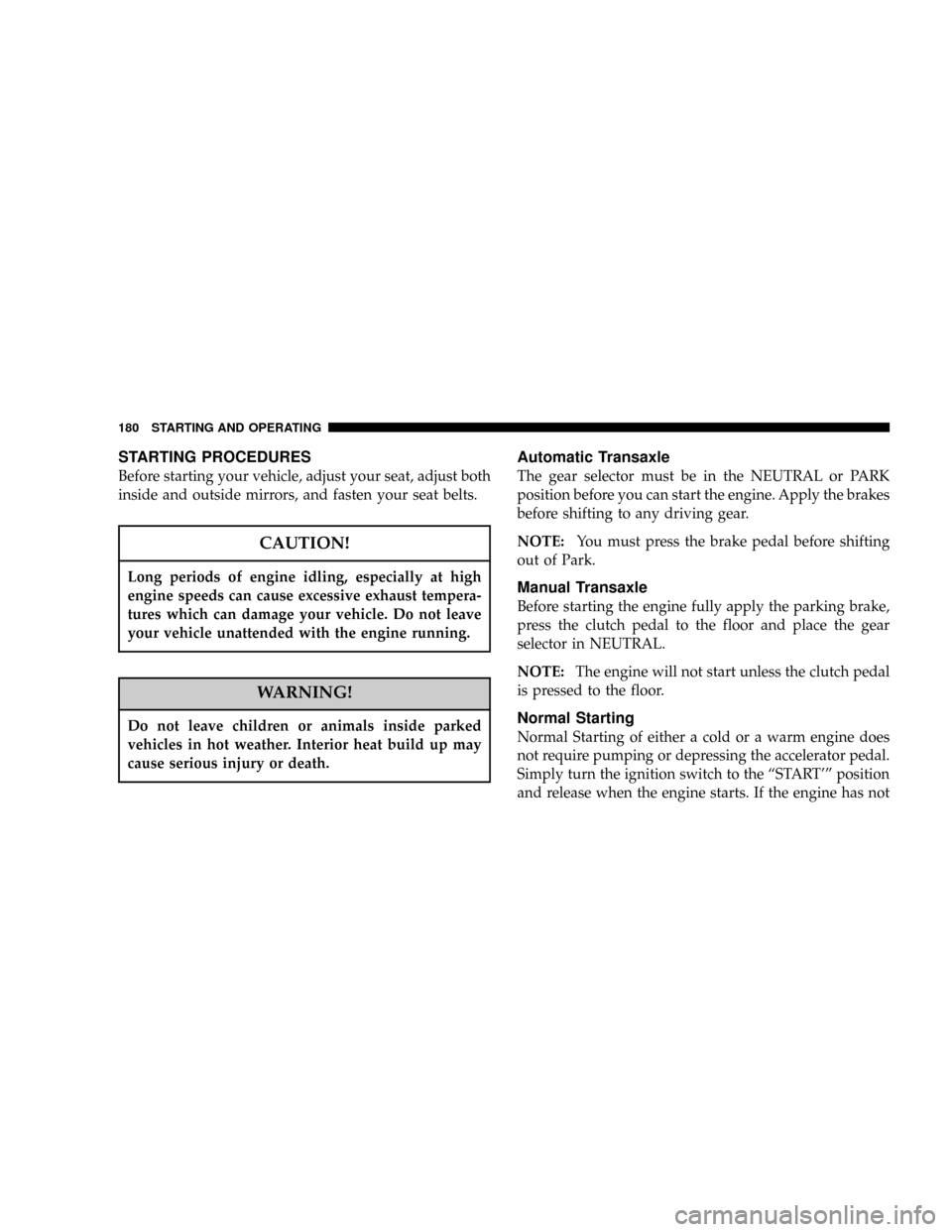CHRYSLER PT CRUISER 2004 1.G Owners Manual
Manufacturer: CHRYSLER, Model Year: 2004, Model line: PT CRUISER, Model: CHRYSLER PT CRUISER 2004 1.GPages: 341, PDF Size: 5.06 MB
Page 171 of 341

Operating Tips
UNDERSTANDING YOUR INSTRUMENT PANEL 171
4
Page 172 of 341

Window Fogging
Vehicle side windows tend to fog on the inside in mild
rainy or humid weather. To clear the windows, use the
A/C, PANEL and blower controls. Direct the panel
outlets toward the side windows. Do not use recirculate
without A/C for long periods as fogging may occur.
Interior fogging on the windshield can be quickly re-
moved by using the defrost position.
If the fogging problem persists, clean the inside window
surfaces. The cause of undue fogging may be dirt collect-
ing on the inside surface of the glass
NOTE:In cold weather, the use of the recirculate
position will cause windows to fog on the inside because
of moisture build up inside the vehicle. For maximum
defogging, use the Outside Air position.
Summer Operation
Air conditioned vehicles must be protected with a high-
quality antifreeze coolant to provide proper corrosion
protection and to raise the boiling point of the coolant for
protection against overheating. A 50% concentration is
recommended.
Outside Air Intake
When operating the system during the winter months,
make sure the air intake, directly in front of the wind-
shield, is free of ice, slush, snow or other obstructions
such as leaves. Leaves collected in the air-intake plenum
may reduce air flow and plug the plenum water drains.
The blower air will heat faster in cold weather if you use
only a low blower speed for the first few minutes of
vehicle operation.
172 UNDERSTANDING YOUR INSTRUMENT PANEL
Page 173 of 341

Side Window Demisters
A side window demister outlet is at each end of the
instrument panel. These nonadjustable outlets direct air
toward the side windows when the system is in either the
FLOOR, MIX, or DEFROST mode. The air is directed at
the area of the windows through which you view the
outside mirrors.
REAR WINDOW FEATURES
Electric Rear Window Defroster
The push-button is located at the center of the
instrument panel, below the radio. Press this but-
ton to turn on the rear window defroster, and the
optional electric remote control heated mirrors. An amber
light shows that the defroster is on.NOTE:The defroster turns off automatically after 10
minutes of operation. Each following activation of the
defroster will last for five minutes.
UNDERSTANDING YOUR INSTRUMENT PANEL 173
4
Page 174 of 341

CAUTION!
To avoid damaging the electrical conductors, do not
use scrapers, sharp instruments, or abrasive window
cleaners on the interior surface of the rear window.
Labels can be peeled off after soaking with warm
water.
Rear Wiper/Washer Switch
A push-button at the center of the instrument panel,
below the radio, turns the rear wiper ON or OFF. When
this switch is pressed the rear wiper will operate at a
fixed interval of about 4 seconds between wipes.Press and hold the switch as long as spray is
desired. If the switch is depressed while the wiper
is on, the wiper will operate for a few seconds after
the switch is released then resume the previously set
mode of intermittent wiper.
174 UNDERSTANDING YOUR INSTRUMENT PANEL
Page 175 of 341

Adding Washer Fluid
The fluid reservoir for the windshield washers and the
rear window washer is shared. It is located in the rear of
the engine compartment on the passenger side and
should be checked for fluid level at regular intervals. Fill
the reservoir with windshield washer solvent (not radia-
tor antifreeze) and operate the system for a few seconds
to flush out the residual water.
UNDERSTANDING YOUR INSTRUMENT PANEL 175
4
Page 176 of 341

Page 177 of 341

STARTING AND OPERATING
CONTENTS
mStarting Procedures.....................180
NAutomatic Transaxle...................180
NManual Transaxle.....................180
NNormal Starting......................180
NExtremely Cold Weather
(Below220ÉF Or229ÉC)................181
NIf Engine Fails To Start.................181
NAfter Starting........................182
NTurbocharger ªCool Downº..............182mAutomatic Transaxle Ð If Equipped.........183
NBrake/Transmission Interlock System.......184
NAutomatic Transaxle Ignition Interlock
System.............................184
NFour Speed Automatic Transaxle..........184
NReset Mode.........................184
NGear Ranges For Four Speed Automatic
Transaxle...........................185
mAutoStick Ð If Equipped.................187
NAutoStick Operation...................187
5
Page 178 of 341

NAutoStick General Information............188
mManual Transaxle Operation...............189
N2.4 Liter TurboÐ If Equipped.............190
NRecommended Shift Speeds..............190
NDownshifting........................191
mParking Brake.........................192
mBrake System..........................194
NAnti-Lock Brake System (ABS) Ð If
Equipped...........................194
mPower Assisted Steering..................196
mTraction Control Ð If Equipped............196
mTire Safety Information...................197
NTire Markings........................197NTire Identification Number (TIN)..........201
NTire Loading And Tire Pressure...........202
mTiresÐGeneral Information................206
NTire Pressure.........................206
NTire Inflation Pressures.................207
NRadial-Ply Tires......................210
NCompact Spare Tire Ð If Equipped.........210
NTire Spinning........................211
NTread Wear Indicators..................212
NReplacement Tires.....................212
NAlignment And Balance.................213
mTire Chains...........................214
mSnow Tires...........................214
178 STARTING AND OPERATING
Page 179 of 341

mTire Rotation Recommendations............215
mFuel Requirements......................216
N2.4L Standard Engine And 2.4L Standard
Turbo Engine........................216
N2.4L High Output Turbo Engine...........216
NReformulated Gasoline.................217
NGasoline/Oxygenate Blends..............217
NMMT In Gasoline.....................218
NSulfur In Gasoline.....................218NMaterials Added To Fuel................219
NFuel System Cautions..................219
NCarbon Monoxide Warnings..............220
mAdding Fuel..........................221
NFuel Filler Cap (Gas Cap)...............221
mVehicle Loading........................223
mTrailer Towing.........................223
NWarranty Requirements.................224
STARTING AND OPERATING 179
5
Page 180 of 341

STARTING PROCEDURES
Before starting your vehicle, adjust your seat, adjust both
inside and outside mirrors, and fasten your seat belts.
CAUTION!
Long periods of engine idling, especially at high
engine speeds can cause excessive exhaust tempera-
tures which can damage your vehicle. Do not leave
your vehicle unattended with the engine running.
WARNING!
Do not leave children or animals inside parked
vehicles in hot weather. Interior heat build up may
cause serious injury or death.
Automatic Transaxle
The gear selector must be in the NEUTRAL or PARK
position before you can start the engine. Apply the brakes
before shifting to any driving gear.
NOTE:You must press the brake pedal before shifting
out of Park.
Manual Transaxle
Before starting the engine fully apply the parking brake,
press the clutch pedal to the floor and place the gear
selector in NEUTRAL.
NOTE:The engine will not start unless the clutch pedal
is pressed to the floor.
Normal Starting
Normal Starting of either a cold or a warm engine does
not require pumping or depressing the accelerator pedal.
Simply turn the ignition switch to the ªSTART'º position
and release when the engine starts. If the engine has not
180 STARTING AND OPERATING